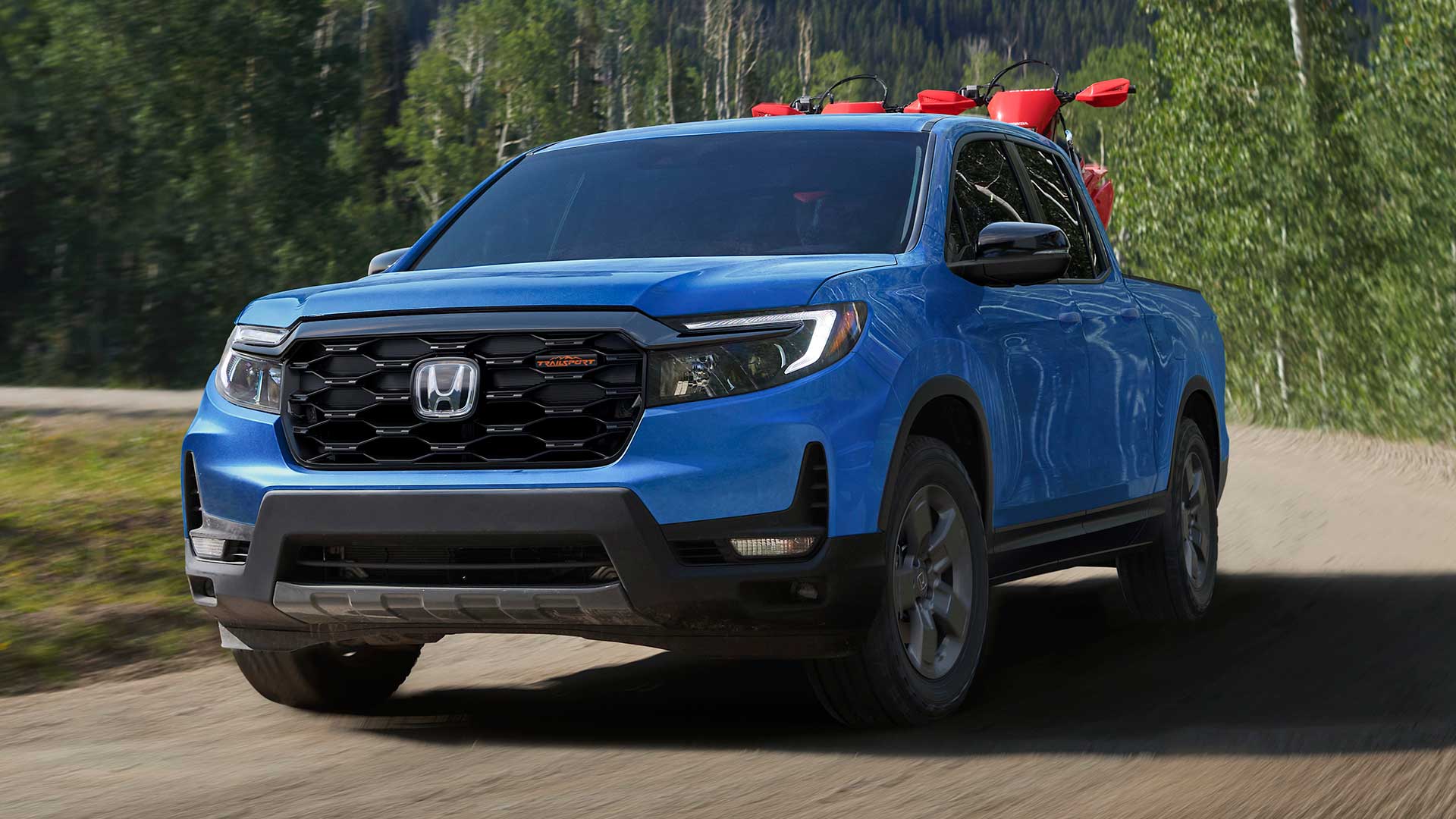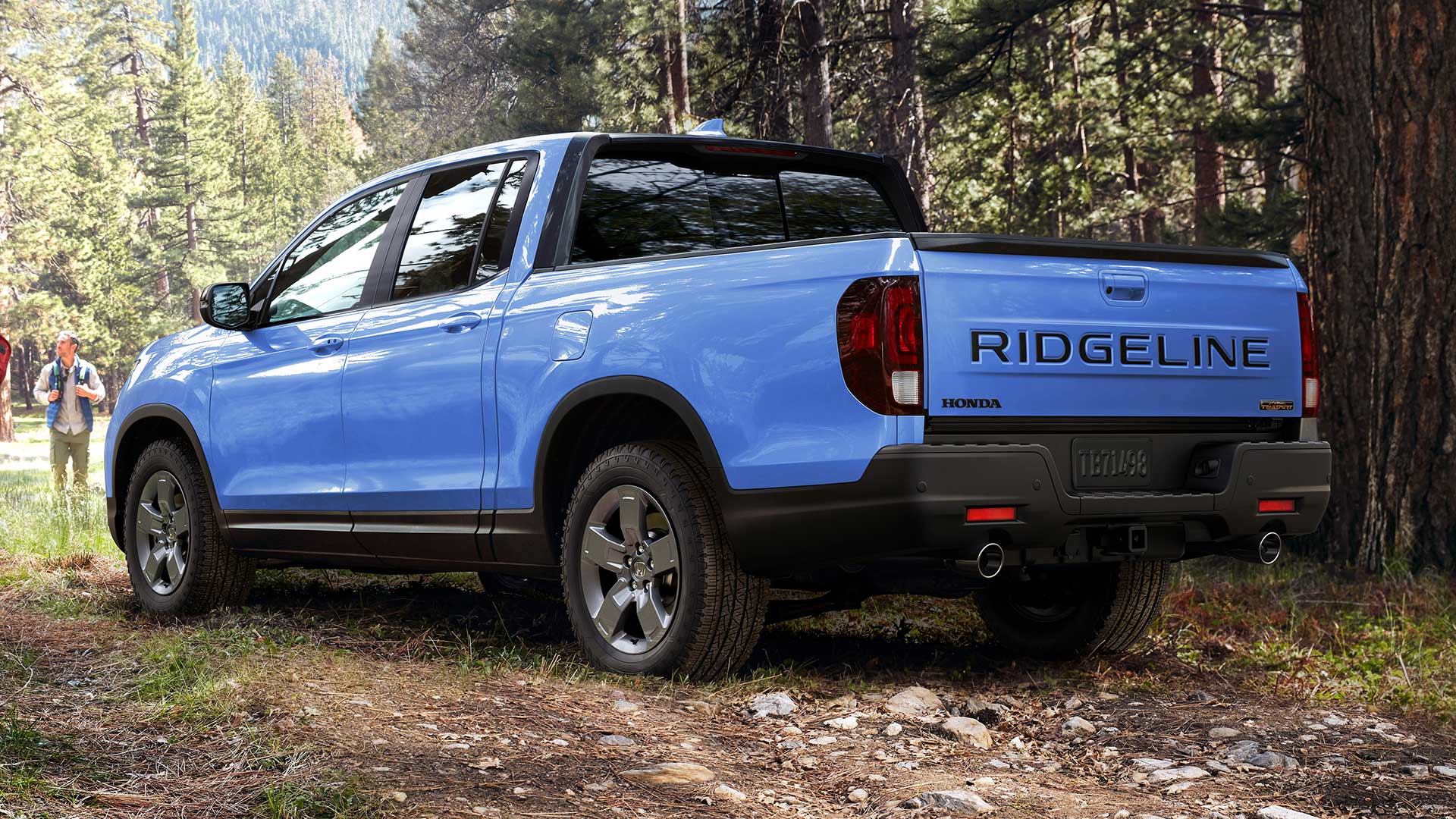2010 Ford Shelby GT500
Carroll Shelby and Ford Mustang. Two names that together have defined American muscle cars for an amazing 45 years. And this is their latest effort, the 2010 Ford Shelby GT500. With fresh hardware from Ford, and fresh inspiration from Shelby, it’s once again poised to conquer just about anything covered with asphalt. So, let’s get to it!
The story of the Ford Shelby GT500 began in 1967 with a menacing double dose of power and style. Four decades later, in 2007, Carroll Shelby’s masterpiece was reborn in 21st century fashion. And for 2010, the Ford-Shelby partnership grows stronger as the latest GT500 is meaner than ever.
Pumping this stallion’s heart blood is the SVT limited edition GT500KR’s 5.4-liter Supercharged V8. Horsepower is up 40 to 540, and torque is up 30 to 510 pound-feet over the previous model. Peak output comes from an intercooled roots-type supercharger, now with nine pounds of added boost.
Sending heaps of power to a shorter 3.55 limited slip rear diff is a re-geared six-speed manual with its iconic cue ball shifter.
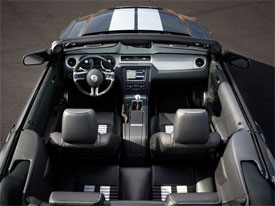 Down the long from straight of Savannah’s Roebling Road raceway, our Mustang roared to 60 in 4.5 seconds, and swallowed up the quarter mile in 12.9 seconds at 112 miles per hour. The GT500’s fat power band delivers full tilt power all the way. The exhaust growl combined with the supercharger whine doesn’t just sound scary, it’s flat-out nightmarish.
Down the long from straight of Savannah’s Roebling Road raceway, our Mustang roared to 60 in 4.5 seconds, and swallowed up the quarter mile in 12.9 seconds at 112 miles per hour. The GT500’s fat power band delivers full tilt power all the way. The exhaust growl combined with the supercharger whine doesn’t just sound scary, it’s flat-out nightmarish.
New SVT suspension tuning was aimed at improving the car’s dynamics. Also to help, new Goodyear F1 Supercar tires on special alloy wheels–19-inchers on the coupe, 18s on the convertible. Stability control is newly standard too, with normal and Sport modes, but can also be turned off.
But even with enhancements, the GT500's full throttle handling remains generally mediocre, especially compared to the Corvettes and Porsches of the world. In Roebling's tight turns, it comes off big and lumbering. With a minimum 3,900-pound curb weight, and relatively soft springs, we were surprised by so much front push and body roll.
But, back off a bit, say to about 80 percent max power, and everything changes. Now the GT500 maneuvers beautifully. Turn-ins are crisp and steering is very responsive. The GT500's power lets you blast out of corners, and the rear can easily be coaxed out by throttle with the ESP off. Also, the shifter works great on the track. Its pattern is tight and just right. And the pedal setup is perfect for "heel and toe" driving.
So, it's only when you push this pony car toward its limits that it scares you off. But that disappointment in a track test makes it one secure high performance car for the street. Indeed, the Shelby GT500 is the ideal backroad entertainer, and when the pavement gets rough, it won't shake your fillings loose like most track stars.
In terms of reeling it all in, the GT500's four-wheel disc ABS setup uses Brembo four-piston calipers up front. Stops were stable and averaged 130 feet, which is OK, but we expected better. Now onto the aggressive cosmetics, always a big part of a Shelby named effort. Most obvious are the signature twin racing stripes, now newly available on the droptop version.
For a meaner front-end, the hood and front fascia now shroud the waffled grille and lower air intake. The coiled Cobra is still there, but new is the front splitter and optional auto headlights. Follow the sharp but broken shoulder line back to a new lower-drag "Gurney Flap" rear spoiler and dual four-inch stainless exhaust tips.
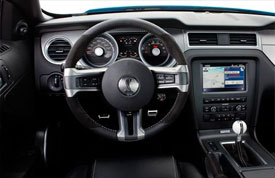 Inside, the familiar four-seat twin-cockpit Mustang cabin is more refined than ever. This classic interior now displays far better materials and craftsmanship. The instrument panel features real aluminum to highlight the SVT-style gauge cluster. Sport seats are leather with embroidered snakes and new Alcantara racing stripe inserts that mimic those on the exterior.
Inside, the familiar four-seat twin-cockpit Mustang cabin is more refined than ever. This classic interior now displays far better materials and craftsmanship. The instrument panel features real aluminum to highlight the SVT-style gauge cluster. Sport seats are leather with embroidered snakes and new Alcantara racing stripe inserts that mimic those on the exterior.
The beefy three-spoke steering wheel wears a hissing snake as well. New technology for the GT500 includes Ford Sync with 911 Assist, as well as an SOS Post-Crash Alert System. And the standard Shaker stereo with CD-changer provides high octane tunes to accompany some serious performance driving. Being a Mustang, the GT500 does have rear seats, but they're way too tight for pretty much any adult to be comfortable.
But here's a surprise-Government Fuel Economy Ratings are 14 city/22 highway. So even with more power, the highway rating is 10% greener than last year. As to how much green you need to lay down, the Shelby GT500 starts at $48,575 for the coupe, and $53,575 for the convertible, which includes a $1000 gas guzzler tax. That's more than a base Corvette, but way less than a 911 or a Viper.
It's fast, it's mean, and it's historic. The 2010 Shelby GT500 is modern Detroit muscle in its purest form. On the track, we admit, it doesn't feel quite at home. But anywhere else, everywhere else, this classic beast rules the roads.Specifications
- Engine: 5.4-Liter Supercharged V8
- Horsepower: 540
- Torque: 510 Lb Feet
- 0-60 MPH: 4.5 Seconds
- 1/4 Mile: 12.9 Seconds @ 112 MPH
- 60-0 MPH: 130 Feet
- EPA: 14 MPG City/ 22 MPG Highway
2024 Honda Ridgeline TrailSport
It Does Truck-Like Things Better Than Ever
Honda brought something truly unique to the pickup truck scene when their mid-size Ridgeline debuted for 2006. In 2017, it moved towards becoming a little more true truck-like, both in form and capability, now with yet another step in that direction for 2024. So, let’s see if the Ridgeline is really hitting its stride.
For 2024, it’s all about making this Honda Ridgeline better than ever. There are styling tweaks outside, along with tech and functional improvements inside, but the biggest news is the Ridgeline has now joined Honda’s TrailSport family of off-road inspired vehicles. This more-true-trucklike, second-gen Ridgeline been around since 2017, receiving periodic updates over the years; but joining the TrailSport family is the biggest leap yet.
Primarily, the TrailSport transformation includes General Grabber all-terrain tires, mounted on new Pewter Gray 18-inch wheels, steel underbody protection, and retuning the strut front, and multi-link rear suspension for added wheel articulation. And while we always appreciate the additional traction of off-road tires, the Ridgeline’s standard i-VTM4 all-wheel drive, with Intelligent Traction Management and snow, sand, and mud settings, was already quite capable of handling all but the most extreme off-roading, ground clearance of just 7.6 inches being it’s only real hinderance.
A 3.5-liter V6 remains under the hood as it has since the Ridgeline debuted for 2006; the current version outputs 280 horsepower and 262 lb-ft of torque, plenty enough muscle to handle its 5,000-lbs. towing capacity. A nine-speed automatic transmission with paddle shifters and bevy of push and pull buttons on the console replaced the six-speed automatic back in 2020.
In addition to adding TrailSport capability, a big focus for this update was making it more user-friendly inside, starting with the central touchscreen growing from 8 to 9 inches. It also gets faster processing speeds, menus have been simplified, and the native navigation system is improved with better graphics. It’s accompanied by a new digital instrument cluster, along with an upgraded center console with more storage space. Unique TrailSport touches include heavy duty floormats, leather-trimmed seats, orange stitching throughout the cabin, and orange ambient lighting.
The Ridgeline continues to offer things available nowhere else in the pickup truck market.
Exterior styling doesn’t exactly shout “macho big rig coming your way,” but the more vertical face and larger grille that arrived for 2021, along with this year’s added TrailSport elements, do continue to toughen up the Ridgeline’s image. The 5’4” bed remains highly functional with no large wheel well intrusions, multiple tie-downs points, lighting and even speakers. And of course, the Ridgeline continues to offer things available nowhere else in the pickup truck market, like the dual-action tailgate, and large, lockable, drainable, underbed storage. Not to mention being able to drive around in true car-like comfort, something we took full advantage of on our way to our Mason Dixon Dragway test track.
There was great grip off the line, with full power arriving smoothly but quickly, helping us to get to 60 in 7.0 seconds flat, a tenth quicker than the last Ridgeline we tested. That power delivery stayed fairly consistent the whole way down the track, barely interrupted by the nine-speed automatic’s smooth shifting. Our best quarter-mile run was 15.5 seconds at 90 mph.
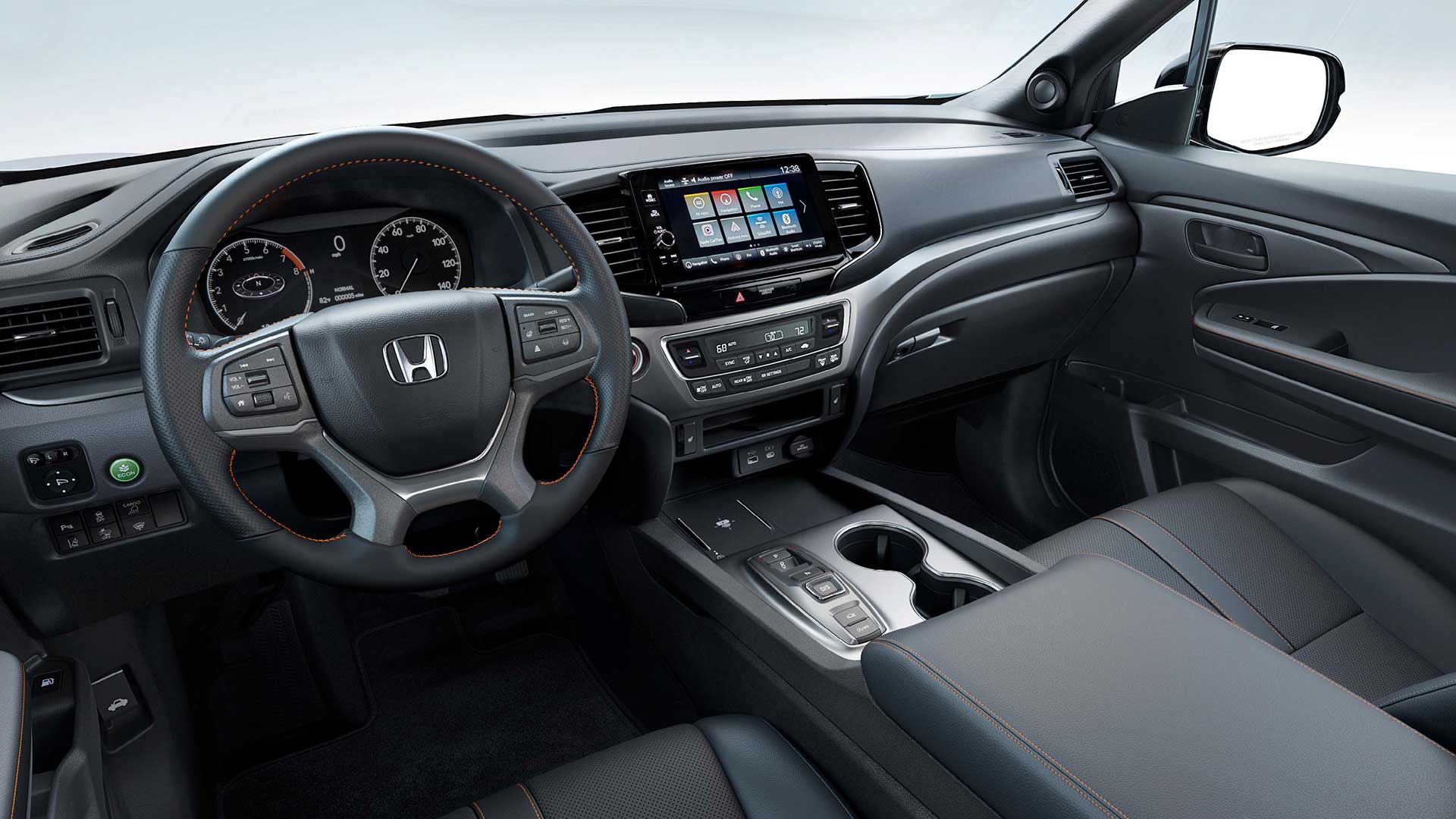
The revised suspension and knobbier tires didn’t really seem to add or detract from handling prowess, as it felt as solid, nimble, and car-like as it always has through our cone course. Perhaps a little less stiff than before, but good feedback, tight steering, and minimal body roll for a pickup, made for a very confidence inspiring experience. In our braking test, we stopped in a respectable average of 123 feet from 60, with only moderate amounts of nosedive and good feel through the pedal.
There is, however, a slight reduction in Government Fuel Economy Ratings with the all-terrain tires; 18-City, 23-Highway, and 20-Combined, our average, right on, at 20.4 mpg of Regular. That’s a slightly below average Energy Impact Score of 14.9 barrels of yearly oil use, with CO2 emissions of 7.4 tons.
TrailSport pricing falls in line just under the Ridgeline’s top Black Edition trim with a starting price of $46,375, about five grand over a base Ridgeline Sport.
So, whether you consider the Honda Ridgeline to be a “real” truck or not, this ruggedly smooth 2024 TrailSport does truck-like things better than ever. And we’re not just talking about the slight upgrade in off-road performance, we’re talking about a flexible bed to help you get chores done, and the ability to tow or haul with comfort and flexibility other trucks can only wish for. It’s why the Ridgeline brings more first-time buyers to Honda than any other vehicle, and why it continues to be a great choice in the growing midsize truck realm.
Specifications
- Engine: 3.5-liter V6
- Transmission: 9-speed automatic
- Horsepower: 280
- Torque: 262 lb-ft
- EPA: 18 City | 23 Highway | 20 Combined
- 0-60 mph: 7.0 seconds
- 1/4 Mile: 15.5 seconds at 90 mph
- 60-0 Braking (avg): 123 feet
- MW Fuel Economy: 20.4 mpg (Regular)
- Max Towing Capacity: 5,000-lbs








